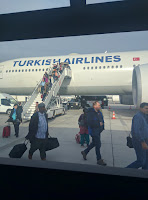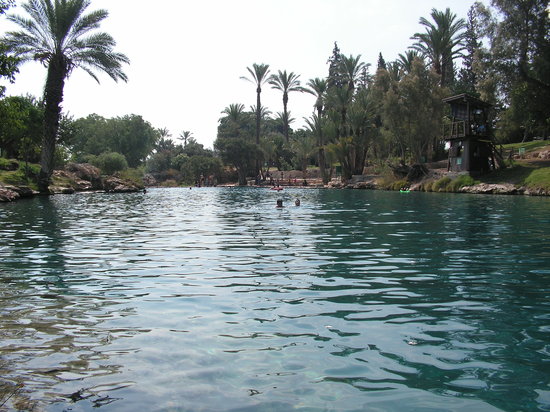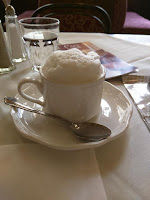 I tried something a bit different this time. I flew Air Transat for my latest trip between Toronto and Tel-Aviv. Air Transat is a charter airline that has been around for about 30 years. But it just opened up service to Tel-Aviv direct from Montreal in June. It flies twice a week - and offers flights at a price than can be less than half of comparable fares on Air Canada or El Al. Sounded like it would be worth a try.
I tried something a bit different this time. I flew Air Transat for my latest trip between Toronto and Tel-Aviv. Air Transat is a charter airline that has been around for about 30 years. But it just opened up service to Tel-Aviv direct from Montreal in June. It flies twice a week - and offers flights at a price than can be less than half of comparable fares on Air Canada or El Al. Sounded like it would be worth a try.The airline currently flies on Sundays and Wednesdays from Montreal to Tel-Aviv and flies back on Mondays and Thursdays. They offer connecting flights between Toronto and Montreal though the connections include medium length wait times - a few hours.
The base price ticket, like some other airlines these days, includes very little. For "economy" passengers to Tel-Aviv, one 30 kg suitcase is included. But headphones, a blanket, an advance seat, a glass of wine, etc., are all $7 each. However, the airline offers an "Option Plus" package that you can buy at the time of booking. It was quite reasonable. It included an extra suitcase (30 kg), priority check-in, an advance seat, free blanket, headphones. wine etc., Even with the Option Plus, the fare was still about half of the available Air Canada fare. So I spoiled myself and bought it.
The flight from Toronto left at about 11 a.m. It was a Boeing 737 and it was completely full. Nothing to report really. It was a standard, uneventful, one hour flight. We arrived in Montreal and had about two hours until the next flight.
The convenient thing, compared to some other connections, is that we did not have to go through security a second time. We remained in the gate area of the terminal. If you fly from Toronto and change planes almost anywhere else on the way to Tel-Aviv, you generally have to clear security a second time at the connecting airport.
There is some special security at the gate for Israeli flights but it is nothing cumbersome.
Our flight was delayed by about two hours, though I have no information about the reasons for the delay so I will give Air Transat the benefit of the doubt.
Boarding was reasonably smooth - especially for me since I had purchased the Option Plus. There is no real "business class" or "first class" on the plane - so the economy seats run right up to the front of the plane. They are quite narrow. I have to say that I felt squished, even compared to seats on the Air Canada 787s. You might simply tell me I should lose some weight - and I'm working on it - but I still felt squished.
I had originally picked out an aisle seat. But since I had Option Plus, they moved me to a more desirable exit row seat. This meant almost unlimited leg room. But it also meant being in an area that would serve as the congregating area for people who want to get together and stretch, chat, pray, or rabble rouse. I would happily refuse the extra leg room next time to avoid being in this area.
The airline was packed with Orthodox and Ultra-Orthodox passengers as well as many secular Israelis. As far as I could tell, there were relatively few Canadian tourists. Air Transat flies Airbus 330s, so it was a fairly large plane. There are personal screens with a selection of movies, games, music and other entertainment. There were not that many newer films but I managed to find a movie or two to watch.
The far more interesting aspect of this particular flight was the discussions that I wound up having with a variety of passengers. On my right, across the aisle, was a retired Israeli officer, secular, but self-described as "traditional." He was flying his whole extended family to Israel for a Bar Mitzvah - more than 20 people - and was interested in telling a group of us all about his experiences in the army and his life story.
To my left, a Russian-Israeli immigrant, who had also served in the Israeli army, worked for a while as a lawyer in Israel and was now living in Ottawa. Although not particularly religious, he told a group of us that he had become actively involved in Chabad in the Ottawa area, though he only mentioned that near the end of the flight. I'll come back to that...
Next to him was a secular but also self-described "religiously respectful" woman who had traveled to Canada from Ra'anana for a tour of eastern Canada. She was on her way back home.
The plane was filled with a large group of Chabad emissaries who were determined to ensure that every male on the plane put on tefillin during the course of the flight. They were using the congregating area - near my seat - to have strategy meetings and decide who to approach and to track their progress.
These young Chabad men were walking up and down the aisles, asking people to put on tefillin. They arrived at our row. The guy on my right, the retired officer, said "no thanks." He said that he doesn't appreciate this kind of thing and had no interest. The guy on my left said that he had already put on tefillin today - so he said no thanks. I simply said no thanks, as well. So these guys continued up and down the aisles and found quite a number of willing participants from what I could see.
Then they came back. "Are you now ready to put on tefillin?" I said "no thanks." He said "what's the matter, don't you believe in the Moshiach?" I said whether or not I believe in the Mashiach is not really related - but I'm fairly sure that your former Rabbi, who is now in a grave in New York, was NOT the Mashiach..." He walked away....
This sparked a whole conversation between the four of us in the row. The woman on the left said that this was all "coercive and embarrassing" and that they should leave people alone. The guy next to her, to my left, defended the Chabad delegate and spoke about how he also used to work in door to door sales, so he knew how hard it was to get people to do things and he empathized with them. He didn't tell us at this point that he had any involvement with Chabad. The guy on my right spoke passionately about how it upsets him that the Ultra-Orthodox do not go to the army and collect large amounts of Israeli state funds while not defending the country.
The four of us continued on to a conversation about the state, the place of religion, gender equality and some other issues. It became quite an active discussion and attracted the participation of a few other passengers in front and in back of our row.
The Chabad guys returned. This time, one of the guys was a bit more forceful, pushing me to agree to put on tefillin. So I finally said to him - "I'll tell you what - if you will agree to put the tefillin on the woman two seats away from me (she was fine with this), then I'll agree to put them on..." He mumbled something about women and walked away...
This brought out the heavy artillery. The senior rabbi of the delegation overheard the discussion and came wandering over, with an entourage in tow. The entourage included his wife and two other young Chabad emissaries. The senior rabbi was apparently the head of a large Borough Park Yeshiva in New York and someone who works closely with renowned Rabbi Firer.
At first, he said, I was "correct" to say that women are able to put on tefillin and that he would have accepted my challenge if he had been the one speaking to me. He noted the example of Rashi's daughter. However, he then began to speak about "Masoret" (tradition) and "Tzniut" (modesty). He explained that women are exempted from many of these Mitzvot and that was simply the tradition. He noted that his own daughter is a physician - so he is not against educating women or limiting them - however Jewish tradition is something different.
So we began discussing the issue of gender equality and Judaism more seriously. All three of the other passengers near me were also involved in the conversation as well as some others. It became quite animated. The Rabbi's wife made her way across the aisle to run interference with the only other woman involved in the conversation (i.e. to take her away from participating directly with the Rabbi).
So I asked the senior Rabbi to explain, where in the Torah it is written that women cannot read Torah or that a man cannot hear a woman's voice singing in public. He said "well that has always been part of our tradition, for thousands of years." I said "can you point to anything that says that?" He said - "well, the Rambam codified it." I asked him when that was....(sometime in the 12th century, CE). He argued that the Rambam was only codifying something that had been around for thousands of years.
So I said to him - "well - you just said it was part of our tradition for thousands of years. But doesn't it say, in the Torah, that Miriam took a tambourine and began to sing when the Israelites were crossing the Reed Sea?" He said - "well she took all the women and went to an area that was women only and then started to sing." I said "where does it say that?" He said "that is how it has always been interpreted..." He said that everyone knows that when it says "b'nai Yisrael" ("children of Israel") in the Torah, it is referring to males only...I challenged him on that.
This discussion became even more heated - with more passengers joining in - including a discussion about the latest controversy over access to the Kotel and the Israeli government's recent decision to give in to the Ultra-Orthodox and roll back access to the Kotel for pluralistic prayer and for the Women of the Wall.
At some point, this Rabbi decided to call it a day and returned to his area, with his entourage. Neither side claimed victory and no one was convinced of the other's position.
But with only two hours remaining in the flight - the former army officer sitting to the right of me decided to agree to put on tefillin and to take a bunch of selfies with the Chabad emissaries. So despite all that he had said, he was either eventually convinced - or became tired of resisting. I found it quite surprising especially after all he had said about Chabad, the Ultra-Orthodox and religious coercion generally. The guy to the left of me opened up and explained how he was very active in a Chabad shul in Ottawa and that most of his family members in Israel were involved in Chabad. So he was quite supportive of everything Chabad was doing, even though he didn't tell us during our initial discussions.
Speaking with these two "secular" Israelis on either side of me, I thought to myself, that is exactly what happens in Israel when it comes to issues of state and religion. The secular majority becomes weary or disinterested and simply gives in on many issues including those relating to funding of Yeshiva students, mandatory military service or access to the Kotel for non-Orthodox groups. The Ultra-Orthodox keep pushing and they eventually get their way on so many of these issues.
With all of these conversations, the flight went by fairly quickly. I did not manage to sleep very much and only watched one movie.
I had ordered an Asian vegetarian meal. It was quite lame compared to what I usually get on Air Canada or Lufthansa - just a bunch of noodles with some onion and mushrooms. I also had one glass of wine, which was also nothing great.
Overall, the flight was fine. Comparable to other airlines. It was not as nice as flying Air Canada or Lufthansa but was probably better than flying El Al or United. And the price was fantastic. The layover in Montreal was a bit inconvenient but, overall, I would probably do this again. I would try to sit in a different section of the plane - away from the mass congregation area. Even if this meant missing out on the opportunity to debate important issues with a few rows of fellow passengers...











